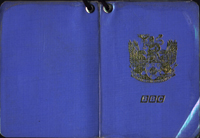
Convoy Attack At Sarajevo Airport
BBC Radio News (& Daily Mail) – 25-11-1992
Approximation of ad-lib report to BBC Radio News filed from Kiseljak.
This was also filed to the Daily Mail.
By Christopher Long

I
t became clear today that Serbian gunmen deliberately used a British aid convoy of twelve lorries as a shield against Muslim retaliation during a fierce fire-fight at Sarajevo airport today. The incident was almost certainly the most dangerous and potentially disastrous yet faced by an aid convoy in Bosnia-Hercegovina.
The twelve lorries, all of whose drivers were on their first ever aid mission in the war-torn republic, were carrying 150 tonnes of wheat flour to the beleaguered Bosnian capital. But they came to an abrupt halt on a narrow, bumpy track beside the main airport runway when 20mm twin-Oerlikon naval guns and a heavy machine gun opened up about one metre in front of the first vehicle, a Range Rover driven by the convoy-leader, Crown Agent Alan Matthews of the British Overseas Development Agency (ODA).
 I was travelling with the convoy from its base at Metkovic and, like the seventeen drivers and crew, sat trapped in my cab as a local Serb military commander continued a sustained attack on Muslim positions on the opposite side of the runway. It was clear that the gunmen were calculating that the Muslims would not return fire with the aid convoy in the way. This was a calculation upon which those of us with long experience here would not have placed much confidence.
I was travelling with the convoy from its base at Metkovic and, like the seventeen drivers and crew, sat trapped in my cab as a local Serb military commander continued a sustained attack on Muslim positions on the opposite side of the runway. It was clear that the gunmen were calculating that the Muslims would not return fire with the aid convoy in the way. This was a calculation upon which those of us with long experience here would not have placed much confidence.
Convoy leader Alan Matthews said later that the Serb commander had appeared dangerously agitated and at one stage looked as if he might turn his guns on the convoy itself.
 The Serbs claimed that their attack was in retaliation for a Muslim assault on a car at the same spot earlier in the day during which two Serbs had been killed and four injured. One of those killed was alleged to have been a close relative of the Serb commander himself.
The Serbs claimed that their attack was in retaliation for a Muslim assault on a car at the same spot earlier in the day during which two Serbs had been killed and four injured. One of those killed was alleged to have been a close relative of the Serb commander himself.
Mr Matthews said that the incident had been potentially disastrous but was full of praise for the cool reaction of his drivers who had sat trapped for about five minutes in the direct line of fire before calmly and slowly reversing their 12 giant lorries back up the track.
Twenty minutes later they advanced again past the now-silent gun positions before negotiating the notoriously dangerous suburb of Dobrinje and then on the Sarajevo central bakery and UNHCR warehouse.


Such incidents occurred almost daily during 1992-95, particularly to Danish, Norwegian and British convoys which were the major distributors of aid throughout Bosnia. More often than not, aid convoys were only allowed through to their destinations after 'payment' of a portion of the consignment (say 20-30 per cent) to armed Croat or Serb militias. In the incident above, a quantity of wheat flour was handed over to Serbs at a check-point before it was allowed into Sarajevo. Extortion of this kind became virtually routine and the UN's collusion in such arrangements was widely believed to have increased its reputation for corrupt and bureaucratic waste and incompetence. Furthermore, it was believed to have encouraged an institutionalised culture of extortion and corruption throughout the region. This continued so long as the UN was responsible for coordinating both an aid programme, through UNHCR, and a 'peace keeping' exercise through UNPROFOR – which was supposed to ensure that aid convoys could pass freely and without hindrance. Eventually, in mid-1995, new troops from Britain and France, operating under NATO command, took de facto control of the peace-keeping role in central Bosnia using decisive military force to ensure local compliance with the free movement of aid. This new force with its uncompromising approach was largely responsible for changing the climate in Bosnia which, a few months later, led to the peace treaty signed in Dayton. This report was also filed to The Daily Mail.
© (1992) Christopher A. Long. Copyright, Syndication & All Rights Reserved Worldwide.
The text and graphical content of this and linked documents are the copyright of their author and or creator and site designer, Christopher Long, unless otherwise stated.
No publication, reproduction or exploitation of this material may be made in any form prior to clear written agreement of terms with the author or his agents.













